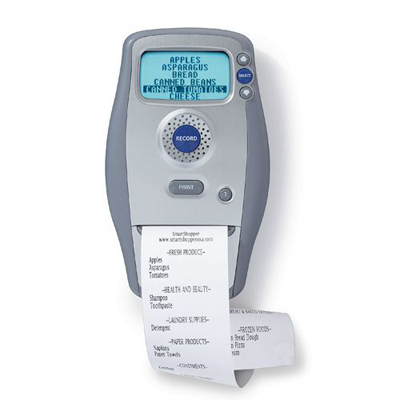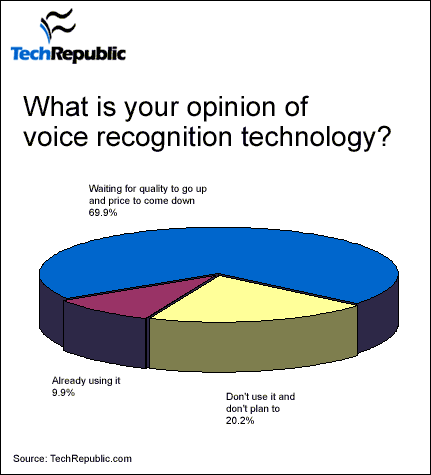Introduction
In the modern world, it has become quite cumbersome to operate businesses and governance affairs without a sound information technology platform. In fact, information technology is basically an essential backbone not only in business but also in government operations. It is definite that several advances have been made in technology especially in information domain ranging from the way information is gathered, stored, analyzed, retrieved as well as disseminated by both business organizations and government agencies. It is against this backdrop that this report explores the concept of voice recognition technology in terms of disadvantages and domain of its use, impacts of this technology on individuals and organizations as well as its future prospects.
Definition of voice recognition technology
To begin with, it is imperative to note that the concept of voice recognition technology is a recent development. It is a technology whereby human words, sounds and phrases are converted into electrical waves in such a way that the moving electrons electronics are coded to give particular meaning. It interprets language being used into text than can be understand depending with the coding. The latter is then saved and progressively transmitted into a designated. In order to obtain the right meaning of the voice projected, there are myriad of internal processes that take place (Obermaisser 215). On the overall, voice recognition technology allows users to transfer voice messages into text without necessarily using known devices such as computer keyboards, mobile phones or typewriters. As a matter of fact, there is need to for a well developed interface between people and machines due to advances that have been made in computing technology.
Problems and Disadvantages of Voice Recognition Technology
There are several problems and disadvantages of voice recognition technology. According to Artman, one of the major problems of this technology is its inaccuracy and perceived level of slowness (www.ehow.com). Although many users cannot type at a high speed as they can speak, this technology is slow because it demands proofreading after taking information. Therefore, the actual device used may be of high speed but the time taken to edit the produced text leads to an overall slow process. As it is now, the voice recognition technology still demands that the spoken words be corrected especially on punctuation and soundness of meaning.
Sometimes this technology does not recognize certain words of phrases unless they are added to the software. Therefore, lack of accuracy that is associated with this new technology is indeed a challenge at hand which is yet to be resolved. It is clear that one cannot proof read text while dictating it, therefore time is wasted while editing the translated text. Definitely, this appears to be a major setback bearing in mind that is possible to type and edit texts simultaneously using the ordinary word processing technologies that are currently in place.
It is also imperative to note that vocal strain is another inevitable problem and disadvantage of voice recognition technology. This is because it requires a person to converse loudly than in normal dialogue. Speaking for many hours may result into serious strain in vocals and this cause vocal injury (Bowker 35). If a person does not take break in between sessions, communication with computer is not efficient because of such straining. Since this technology demands dictation, many users would find that is not comfortable to spend long hours processing small amount of information. Vocal strain does not create a comfortable environment while working.
Furthermore, voice recognition technology has been found to be environmentally unfriendly. Its program requires an ideal and a quite environment away from noise. A noisy environment may significantly hinder voice recognition software to recall any voice. It is definite that there are two factors to put into consideration here. Firstly, this technology can only work well in a quiet environment free from external or internal sources of noise. Secondly, the technology is bound to pollute the immediate environment through noise. For instance, if group or groups of people were to use this technology within the same spot, the end result would not be desirable.
This means that unnecessary information may be captured by a voice recognition device especially if its microphone has limited ability to filter out such noises. However, it is not necessary to use a keyboard in an ideal environment. It also interprets odd voices if the user fails to adjust to preset accent. Moreover, another problem associated with using this technology is that most users are likely not to remember verbal commands (Khosrowpour 15). In the case of keyboard commands, it is pretty easy to recall basic commands that are required to produce required texts.
Domain of use
Most of the major industries are currently using voice recognition technology. Some of these domains include space science, disaster relief, construction sector, manufacturing, mining, education, energy, communication and transport. It is also imperative to note that the rate at which the domain of using this technology is expanding is rater fast.
Voice recognition technology can be used in military domain, learning institutions, health care centers. The other places in which this technology can be put into use include courts, government agencies and industrial sectors. All these targeted users have found it necessary and quite handy to use the voice recognition technology. Many health institutions had adopted this technology to improve its operations. In the military, it has been used for security purposes and improving efficiency in communication. On the same note, industrial sectors use this technology to improve their marketing strategies. Some organizations use Electronic Shopping Organizer gadget to sell products. The gadget is illustrated below

Impact of Technology on Organization and Individual
Voice recognition technology has great impact both on corporate organizations and individuals. Its impact can be seen through the way it has benefited its users. For example, the speed at which computer users type vary greatly from one individual to another. Many people are slow in typing and this technology had helped individuals because it is easier to speak than typing. A person can speak several words than actually going through the typing process. In this case, a person may produce large amount of information when using voice recognition device than when typing.
Mobility is yet another direct impact to individual users of voice recognition technology. One can walk freely and does not need to stay intact in one given computer. Hands and eyes are also free while using this technology. When a person is seated closely to a computer, his eyes and hands cannot be away from it. The technology has positively impacted the lives of people with physical and visual impairment.
Speech recognition technology has enhanced positive performance in organizations and industries. It is effective to use this technology in different departments. The development of this technology had impacted organizations in business markets, products and their relationships with customers. A good example of its impact is how it had promoted good performance in hospitals. Many hospital institutions had adopted it to improve correctness of reports and to have quick access to patient information. Eventually, it brings some impact to organization through influencing its efficiency on operational cost. Mobile industries are examples on how this technology has brought great impact. It has become easier and faster to have all information through the mobiles. A good example of its impact on phones is Parrot Mini Kit hands free mobile speaker. The following picture illustrates how this phone as used best in class:

One of the major impacts of voice recognition is on the field of medicine. Increased application of the technology has decimated communication barriers in medical field. This implies that voice recognition tools have enhanced medical practitioners to keep computerized medical records. Moreover, physicians and patients can easily capture the notes and information that is essential for health purposes. In line with this, the technology has increased the proportion of patients who receive medical tests, treatment and prescription that need to be documented. In this case, voice recognition technology has enhanced prompt and accurate documentation of information to patients, thereby facilitating most favorable outcomes.
Whereas the technology has widely been used in hospitals, it has also impacted positively in other fields such as courts. Through use of speech technology, it is possible to identify individuals who have committed criminal offences. Use of sophisticated tools has enhanced crime investigators to reveal spoken information at the time when crime was committed. However, this technology appears a bit technical and challenging especially when crime investigators need to decode speech to data. In addition, speech technology has facilitated research work.
Researchers use speech recognition tools to literally decode information provided by respondents into desired form of data. Speech recognition engine has also impacted highly on the field of education. For instance, teachers dictate new concepts to learners whose pronunciation is transferred into a verbal form in order for the teacher to access their understanding. This is essential for the teacher to teach learners on grammar and pronunciation during language lessons. In this case, speech recognition tools are relied upon specifically for learning purposes. In this case, positive impacts have been identified in all the afore-mentioned fields.
Future Development
Indeed, voice recognition technology will definitely continue to experience various phases of development in the future. For instance, Japan is already using android projects while mirroring or facial expression are becoming common place in United States of America. The bigger picture is to synchronize machines with human bonds or emotions. Finally, we expect voice recognition technology to be embedded alongside facial expression and body language.
Additionally, empathy and emotion can also be emulated with some of the latest software developments in voice recognition. Currently, there are relentless attempts to differentiate voice emanating form computer machines with those of real human being in order to detect fraud.
There is future need to enhance this technology in order to address some of the problems while using it. Additionally, achievable development would require future research that is able to guarantee a program addressing these problems and limitations. The following chart explains how users have different opinions about vocal recognition technology.

Report conclusion
In conclusion, it is imperative to note that voice recognition technology is a recent development in information technology and has been positively received in the market as one of the alternatives to quick production and dissemination of information in form of text messages. While there are myriad of problems associated with the use of this technology, it is profound to note that its innovation is a step in the right direction. As noted in the paper, some of the problems and disadvantages of voice recognition technology include noise pollution, less speed due to additional time needed for editing and preset accents that some users may not be familiar with, among others. On the other hand, this technology has been proved to be quite helpful in various domains such as in the military, learning institutions as well as industries.
Works Cited
Artman, Jason. The Disadvantages of Voice Recognition Software. 2011. Web.
Bowker, Lynne. Computer-aided Translation Technology: A practical Introduction. Ottawa: University of Ottawa, 2002.Print.
Khosrowpour, Mehdi. Annals of Cases on Information Technology. Hershey: Idea Group Publishing, 2002. Print.
Obermaisser, Roman. Software Technologies for Embedded and Ubiquitous Systems. New York: IFIP International Federation for Information Processing, 2007.Print.